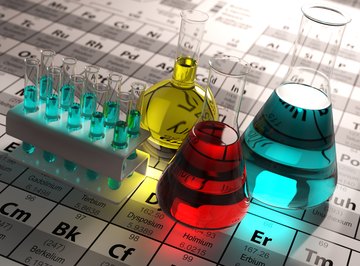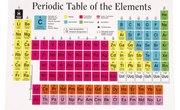
When trying to find the number of neutrons, protons or electrons that different chemical species have, the periodic table is your best friend. Take a look at how to use the periodic table as well as nuclear notation to find the number of subatomic particles associated with any chemical species.
Reading the Periodic Table
The periodic table tells a lot of what you need to know about each element, including the number of electrons, protons and neutrons.
Take a look at the periodic table entry for carbon (see the Resources section). What information does the entry for carbon give you?
1. The biggest component is the chemical symbol for the element. For carbon this is C.
2. Above the symbol is the atomic number (Z) which is equal to the number of protons in the nucleus and the number of electrons in the electron cloud (given that the atom is neutral). For carbon Z=6.
3. Below the symbol is the atomic mass. While this number is a weighted average of the masses of all isotopes of the element, if you round the number to the nearest whole number you will find the mass number of the most common isotope. For carbon the mass number (M) is 12. This number is the sum of the number of protons and neutrons.
Now, you know that for a neutral carbon atom the number of electrons is six, the number of protons is six, but what is the number of neutrons? You can use the mass number to find this. Simply take M and subtract Z. For carbon this means that there are six neutrons.
Finding the Number of Subatomic Particles in Ions
Ions are formed when an atom either loses or gains electrons. The number in the superscript will tell you the magnitude of this change. Say you have Cl-. How many electron, protons and neutrons does this ion have?
The process for finding these values is very similar to what was done above. However, now, you need to account for the fact that the atom is not neutral.
From reading the periodic table you can tell that chlorine has 17 protons and 18 neutrons (given by M-Z, or 35-17).
Given that the net charge is negative, there must be more electrons than protons. You can use the following equation:
Plugging in 17 for protons (p+) and -1 for the charge gives:
So:
Thus, a chlorine ion has 18 electrons.
Finding the Number of Subatomic Particles in Isotopes
Isotopes are forms of the same element with different numbers of neutrons. The number of protons cannot be changed since once that number (Z) changes, so does the element. When talking about isotopes, nuclear notation can often be helpful.
Using nuclear notation, carbon-12 would be written 126C.
Nuclear notation tells you three things:
1. The chemical symbol of the element (C for carbon in the example above)
2. The mass number or the number neutrons and protons in the nucleus is the superscript (12 in the example above). Mass number = # of neutrons + # of protons. Hint: This is the number to look out for when examining isotopes.
3. The atomic number or the number of protons (Z) is the subscript. This is always the same for an element. (6 for carbon in the example above).
For example, carbon-12 would be written 126C in nuclear notation, but the isotope carbon-13 would be written 136C. So then how many electrons, protons and neutrons does carbon-13 have?
The number of protons and electrons is the subscript (6).
To find the number of neutrons use the following equation:
Plugging in what you know yields:
So:
Carbon-13 has seven neutrons while carbon-12 has six.
References
Resources
About the Author
Riti Gupta holds a Honors Bachelors degree in Biochemistry from the University of Oregon and a PhD in biology from Johns Hopkins University. She has an interest in astrobiology and manned spaceflight. She has over 10 years of biology research experience in academia. She currently teaches classes in biochemistry, biology, biophysics, astrobiology, as well as high school AP Biology and Chemistry test prep.
